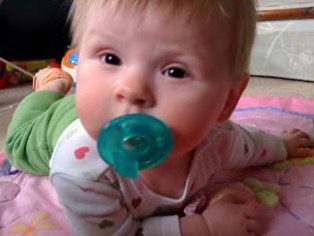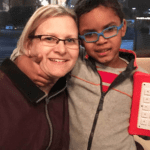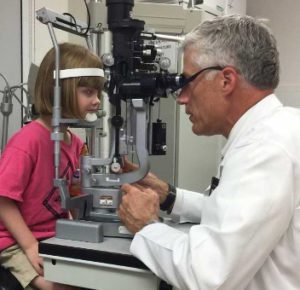New Parent Guide
We know that for some of you, the diagnosis of Aniridia syndrome has come as a complete shock. However, we are here to help you learn, be supportive, and provide advice. We have supporters young and old who were born with Aniridia syndrome and are willing to share their experiences.
Parents and families are also involved and willing to provide support from their perspective. We also have a great resource book about Aniridia syndrome, Aniridia and WAGR Syndrome: A Guide for Patients & Families. The book is available through the Aniridia Foundation International office, Oxford University Press, Barnes & Noble, and Amazon.

A Message to Remember
It may seem overwhelming now; however, our foundation gives you the tools to succeed. You can learn through our medical conferences where we bring in top doctors experienced in Aniridia syndrome to speak to you. You can receive support by networking with families who have experience with the challenges of Aniridia syndrome. You will meet many children, teens, and adults with Aniridia syndrome who have excelled despite their limited vision helping you understand what your child's life might be like. Grandparents, parents and other relatives are also supporters and can give their very special perspective and support.
 Children with Aniridia syndrome who have not had significant complications often have vision somewhere between 20/80 and 20/200 once their vision matures. It has been observed; however, that it can take some time for an aniridic infant's eyes to "wake up" and fully begin to use their vision. As such, a true sense for how well a child will see may not be fully determined until they are preschool age or even early elementary. So, if you are a parent of an infant, and you are concerned that your child may not be able to see much, please know that this may improve for the first few years of your child’s life.
Children with Aniridia syndrome who have not had significant complications often have vision somewhere between 20/80 and 20/200 once their vision matures. It has been observed; however, that it can take some time for an aniridic infant's eyes to "wake up" and fully begin to use their vision. As such, a true sense for how well a child will see may not be fully determined until they are preschool age or even early elementary. So, if you are a parent of an infant, and you are concerned that your child may not be able to see much, please know that this may improve for the first few years of your child’s life.  There are a few reasons that genetic testing is recommended for babies born with Aniridia syndrome:
There are a few reasons that genetic testing is recommended for babies born with Aniridia syndrome:
- To confirm that there is either a mutation or deletion in short arm of the chromosome 11p13 affecting the PAX6 gene.
- To determine whether there is a larger deletion leading to a WAGR Syndrome diagnosis.
- To allow doctors and parents to provide the best care possible and to give a better idea of the medical or developmental issues that should be monitored.
- To determine eligibility for future treatments and research trials.
 It is important to partner with good doctors to help you care for your child. To start with, your child will need to see a pediatric ophthalmologist (every 3-6 months), a primary care provider, an imaging provider for ultrasounds (every 3-6 months, depending on the results of genetic testing), and a geneticist. It is also important, especially for any surgery needed to see an ophthalmologist with successful, extensive experience with Aniridia syndrome and who knows the latest information. We can often assist our supporters with suggestions of those surgeons that have this expertise profile or provide special introductions to them.
It is important to partner with good doctors to help you care for your child. To start with, your child will need to see a pediatric ophthalmologist (every 3-6 months), a primary care provider, an imaging provider for ultrasounds (every 3-6 months, depending on the results of genetic testing), and a geneticist. It is also important, especially for any surgery needed to see an ophthalmologist with successful, extensive experience with Aniridia syndrome and who knows the latest information. We can often assist our supporters with suggestions of those surgeons that have this expertise profile or provide special introductions to them.
Think of the eye as a camera and the shutter is the iris. If too much light is let into the camera lens, the picture will be washed out or overdeveloped. This makes the definition of objects hard to see. When too much light falls onto the retina, it can cause discomfort and loss of visual acuity. Artificial lighting indoors can also cause glare. Vision can be diminished for anyone when glare is involved. For this reason, pick sunglasses for babies and children with polarized lenses to block out the glare. There are special sunglasses made for babies and a brimmed hat can also help.
Some children may try to control light by squinting or have a condition known as ptosis (toe-sis). This is where the eyelids droop to compensate for the light entering the eye. Often it may look like the child is sleepy to others who do not know of the eye condition.
 One of the most frequently asked questions by new parents is “What are the best sunglasses for my baby?” Be aware your baby/child will not keep the hat or sunglasses on for long. He/she may pull them off right away. Don’t stress about this! Your child will get used to them. Just make it a habit of putting them on and if your child takes them off, put them back on. Children go through phases and will refuse to wear sunglasses and a hat. Just be supportive and encourage your child to wear them when he/she is comfortable. Help your child understand the sunglasses will not only help reduce the sunlight for them, but the sunglasses will protect their eyes from the sun.
One of the most frequently asked questions by new parents is “What are the best sunglasses for my baby?” Be aware your baby/child will not keep the hat or sunglasses on for long. He/she may pull them off right away. Don’t stress about this! Your child will get used to them. Just make it a habit of putting them on and if your child takes them off, put them back on. Children go through phases and will refuse to wear sunglasses and a hat. Just be supportive and encourage your child to wear them when he/she is comfortable. Help your child understand the sunglasses will not only help reduce the sunlight for them, but the sunglasses will protect their eyes from the sun.
Sunglasses our parent's recommend:
- Julbos
- Baby Banz
- Ro*Sham*bo Baby Sunhats
Look for hats that have a wide brim. Baby Banz and Sunday Afternoons have sunhats with sun protection, but you can always find a bucket hat from your local store and it should do the trick.
Yes, your child will have struggles, but… All children have struggles. All humans have struggles – this realistically is just part of the human condition. Parents often fear the idea that their child will have limits due to their vision. However, all people have limits – we all have abilities and disabilities, things we are good at and things we are not.

Your child will amaze you in so many ways. People with Aniridia syndrome can skateboard, ride bikes, play golf and basketball, go zip lining, go hiking, and more. Adults with Aniridia syndrome get married, have children, work full time, and own their own businesses. Yes, there will be challenges, but there will also be joys beyond compare! You will never take for granted the small things – when your child first sees a rainbow, or when he first reads a book, or when she conquers an obstacle that you once thought was impossible.
"Aniridia syndrome is not that big of a deal! I mean, sure, sometimes I have challenges but my life is good!")
-Elli C., age 10